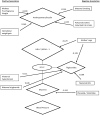Maternal and pregnancy related predictors of cardiometabolic traits in newborns
- PMID: 23418462
- PMCID: PMC3572188
- DOI: 10.1371/journal.pone.0055815
Maternal and pregnancy related predictors of cardiometabolic traits in newborns
Abstract
Background: The influence of multiple maternal and pregnancy characteristics on offspring cardiometabolic traits at birth is not well understood and was evaluated in this study.
Methods and findings: The Family Atherosclerosis Monitoring In earLY life (FAMILY) Study prospectively evaluated 11 cardiometabolic traits in 901 babies born to 857 mothers. The influence of maternal age, health (pre-pregnancy weight, blood pressure, glycemic status, lipids), health behaviors (diet, activity, smoking) and pregnancy characteristics (gestational age at birth, gestational weight gain and placental-fetal ratio) were examined. Greater gestational age influenced multiple newborn cardiometabolic traits including cord blood lipids, glucose and insulin, body fat and blood pressure. In a subset of 442 singleton mother/infant pairs, principal component analysis grouped 11 newborn cardiometabolic traits into 5 components (anthropometry/insulin, 2 lipid components, blood pressure and glycemia), accounting for 74% of the variance of the 11 outcome variables. Determinants of these components, corrected for sex and gestational age, were examined. Baby anthropometry/insulin was independently predicted by higher maternal pre-pregnancy weight (standardized estimate 0.30) and gestational weight gain (0.30; both p<0.0001) and was inversely related to smoking during pregnancy (-0.144; p = 0.01) and maternal polyunsaturated to saturated fat intake (-0.135;p = 0.01). Component 2 (HDL-C/Apo Apolipoprotein1) was inversely associated with maternal age. Component 3 (blood pressure) was not clustered with any other newborn cardiometabolic trait and no associations with maternal pregnancy characteristics were identified. Component 4 (triglycerides) was positively associated with maternal hypertension and triglycerides, and inversely associated with maternal HDL and age. Component 5 (glycemia) was inversely associated with placental/fetal ratio (-0.141; p = 0.005). LDL-C was a bridging variable between the lipid factors and glycemia.
Conclusions: Maternal health, health behaviours and placenta to fetal weight ratio are associated with newborn cardiometabolic traits over and above gestational age. Future investigations are needed to determine if these factors remain important determinants of cardiometabolic health throughout childhood.
Conflict of interest statement
Figures

References
-
- Yusuf S, Hawken S, Ounpuu S, Dans T, Avezum A, et al. (2004) Effect of potentially modifiable risk factors associated with myocardial infarction in 52 countries (the INTERHEART study): case-control study. Lancet 364: 937–952. - PubMed
-
- O’Donnell MJ, Xavier D, Liu L, Zhang H, Chin SL, et al. (2010) Risk factors for ischaemic and intracerebral haemorrhagic stroke in 22 countries (the INTERSTROKE study): a case-control study. Lancet 376: 112–123. - PubMed
-
- Berenson GS, Srinivasan SR, Bao W, Newman WP, Tracy RE, et al. (1998) Association between multiple cardiovascular risk factors and atherosclerosis in children and young adults. The Bogalusa Heart Study. N Engl J Med 338: 1650–1656. - PubMed
-
- Barker DJ, Winter PD, Osmond C, Margetts B, Simmonds SJ (1989) Weight in infancy and death from ischaemic heart disease. Lancet 2: 577–580. - PubMed
-
- Morrison KM, Atkinson SA, Yusuf S, Bourgeois J, McDonald S, et al. (2009) The Family Atherosclerosis Monitoring In earLY life (FAMILY) study: rationale, design, and baseline data of a study examining the early determinants of atherosclerosis. Am Heart J 158: 533–539. - PubMed
Publication types
MeSH terms
Substances
LinkOut - more resources
Full Text Sources
Other Literature Sources
Medical

